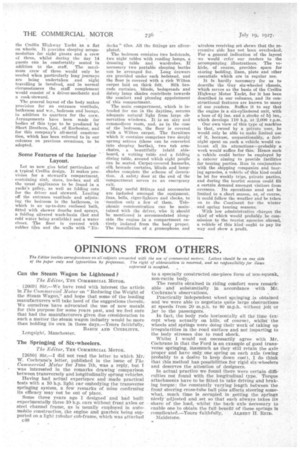OPINIONS FROM OTHERS.
Page 62

If you've noticed an error in this article please click here to report it so we can fix it.
The Editor invites correspondence on all subjects connected with the use of commercial motors. Letters should be on one side of the paper only and typewritten by preference. The right of abbreviation is reserved, and no responsibility for Oiews
expressed is accepted.
Can the Steam Wagon be Lightened ?
The Editor, THE COMMERCIAL MOTOR.
• 126091 Sir—We have read with interest the article in The Commercial Motor on "Reducing the Weight of the Steam Wagon,'.' and hope that some Of the leading manufacturers will take heed of the suggestions therein. We ourselves -have advocated the use of new metals for this purpose for some years past, and we feel sure that had the -manufacturers given clue consideration to such a matter the steam wagon industry would be more than holding its own in these days.—Yours faithfully, BA SON AND CONDLIFFE. Longsight, Manchester.
The Springing of Six,wheelers.
The Editor, THE COMMERCIAL MOTOR.
F2610] Sir,—I did not read the letter to which Mr. W. Cochrane's letter, published in the issue of Tice Commercial Motor for June 7th, was a reply, hut was interested in the remarks drawing comparison between transversely and longitudinally sprung vehicles.
Having had actual experience and made practical tests with a 10 h.p. light car embodying the-transverse springing system, a few remarks of mine confirming its efficacy may not be out of place.
Some three years ago I designed and had built experimentally three 10 h.p. cars without front axles or steel channel frame, as is usually employed in automobile construction, the engine and gearbox being supported on a light tubular sub-frame, which was attached c40 to a specially constructed one-piece form of non-squeak, non-rattle body.
The results obtained in riding comfort were remarkable and substantially in accordance with Mr. Cochrane's observations.
Practically independent wheel springing is obtained and we were able to negotiate quite large obstructions at speeds from 20 m.p.h. to 40 m.p.h. without jolt or jar to the passengers.
In fact, the body rode horizontally all the time (except when actually on hills, of course), whilst the wheels and springs were doing their work of. taking up irregularities in the road surface and not imparting to the body stresses due to road shock.
Whilst I would not necessarily agree with Mr. Cochrane in that the Ford is an example of good transVerse springing, inasmuch as they still retain the axle proper and have only, one spring on each axle (owing probably to a desire to keep down cost), I do think that this method has possibilities for rigid six-wheelers and deserves the attention of designers.
In actual practice we found there were certain difficulties not found with the longitudinal type. Torque attachments have to be fitted to take driving and braking, torque; the constantly varying length between the front steering cross-tube ball pins affects steering somewhat, much time is occupied in getting the springs nicely adjusted and set so:that each always takes its share of the load, whilst the backaxle necessary to enable one to obtain the full benefit of these springs is
complicated.—Yours faithfully, ALERT H. REID. Maidstone,












































































































